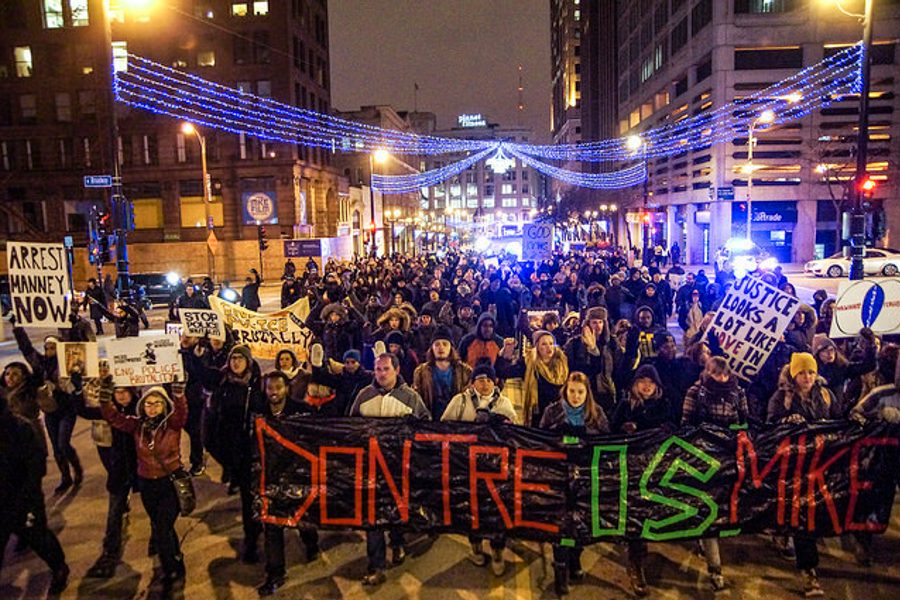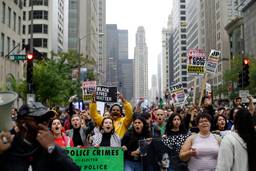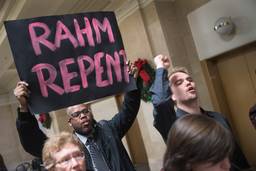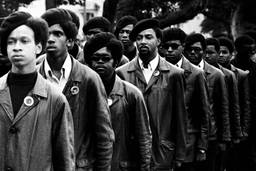In Milwaukee, a History of Racist Violence Fuels Mistrust of the Police Department
A recent shooting recalls the decades of abuse inflicted on the city’s African-American community by police.
Flint Taylor

On August 13, a 24-year-old African-American police officer named Dominique Heaggan-Brown shot and killed a 23-year-old African-American man named Sylville Smith in broad daylight. The shooting, which occurred in the heart of Milwaukee’s north side, a predominantly African-American community, may have been legally justified — Milwaukee’s mayor and its police chief have claimed that video from the officer’s body camera shows Smith turning toward the officer holding a handgun and an autopsy shows that he was shot in the arm and chest — but the shooting, and the uprising that followed, shined a harsh light on Milwaukee and its segregated neighborhoods, impoverished African-American population, failing inner-city schools, disproportionately high incarceration rate for young African-American men and out-of-control police force.
While Donald Trump brazenly calls for more police in the community and his reactionary surrogate, Milwaukee County Sheriff David A. Clarke Jr., has blamed the “creeps” in the “Black Lies Matter” movement for the uprising, a young African-American man sized up the situation differently.
“When it finally all over-boiled and people got tired of the oppression, that’s what happens: People just take out their anger the best way they can,” Tay Smith, 23, who lives about three miles from where Smith was shot, told The Milwaukee Journal Sentinel. “If they ain’t got nowhere to go, they tear up their own neighborhood, tear up their own things.”
The Milwaukee Police Department (MPD) is, and has always been, the aggressive enforcer of this oppression on the streets of Milwaukee’s north side. This is powerfully demonstrated by its history, past and present, of racist beatings and shootings, a proliferation of racial profiling enforced by illegal stops, frisks and arrests, a pattern and practice of invasive strip and body cavity searches, a pervasive police code of silence and other modes of police repression, with the MPD brass displaying a callous indifference to, and tacit encouragement of, this wanton and systemic misconduct.
In These Times reached out to the MPD for comment on this story. It did not respond.
History of racist violence
Going back almost 60 years, Milwaukee police officer Thomas Grady fatally shot Daniel Bell, a black man the officer claimed was wielding a knife. The officer’s story, aided by the recovery of a knife at the scene, was accepted without serious challenge until, some 20 years later, Grady’s partner broke the MPD’s code of silence and revealed that Grady had said that he was going to arrest “some n — –rs” that night, that Bell was unarmed, that Grady had planted the knife on Bell and that he had dismissed Bell’s fatal shooting by saying, “He’s just a damn n — -r kid anyhow.”
In 1964, the all-powerful Harold A. Breier, who by law had a lifetime appointment, took over as chief of the MPD. Condemned by many as a racist, he opposed integration, claiming that by integrating the schools, Milwaukee was “busing crime all over the city.” After protests in 1966, Breier initiated an intense surveillance of the Milwaukee NAACP Youth Council and its spiritual leader, Father James Groppi. The officers assigned to the case would often harass Youth Council members and jail them for all manner of minor offenses such as littering or jaywalking. During the open housing marches that Groppi led in the late 1960s, Breier ordered all Milwaukee police officers who were supposed to protect the Youth Council to remove their badges so that they could not be identified if they brutalized the marchers.
A U.S. Department of Justice investigation found that 22 people died in MPD custody between 1975 and 1979. In 1981, Breier’s officers brutally beat an African-American man named Ernest Lacy, then refused to provide medical assistance for him as he lay dying. Despite the fact that Lacy had more than 30 cuts and bruises on his body, Breier proclaimed that the officers who administered the fatal beating did nothing wrong and refused to cooperate with a federal investigation. Three years later, Breier stepped down from his lifetime appointment, but the MPD continued its brutal and racist ways.
In 1991, in the wake of the notorious Jeffrey Dahmer case, where the MPD failed to arrest a serial rapist and murderer, the MPD was subjected to scrutiny by a commission mandated by then-Mayor John Norquist. The commission found that the Milwaukee Fire and Police Commission (FPC) received 206 citizen complaints, including 83 excessive force complaints, for the previous six years. Just 14 of those 206 complaints proceeded to trial before the FPC; the complainant was found to have failed to meet his or her burden of proof in 13 of those cases. The report also cited the MPD’s code of silence and recommended that psychological screening of recruits be instituted.
“Broken windows” policing
In the 2000s, the MPD consciously pursued a policy of “proactive policing,” Milwaukee’s version of the “broken windows” strategy that was popularized by New York City Police Commissioner William Bratton. In District Three, which adjoins the district in which Smith was shot, a young officer named Jason Mucha implemented this strategy with uncommon zeal. Encouraged by his commanding officer, who said that the goal of Mucha’s specialized unit should be to make the “lives of thugs miserable,” Mucha racked up complaints for brutality, illegal arrests and searches and the planting of drugs. The unit also employed another tactic that community members dubbed the train — lining up three or four police cars back-to-back on certain blocks in order to intimidate residents.
In 2004, Milwaukee was rocked by another case of wanton police brutality. Several off-duty white officers savagely beat and tortured an African-American man named Frank Jude. The on-duty officers who came to the scene joined with the brutalizers in an attempt to cover-up the crimes. Milwaukee County District Attorney Michael McCann, during an unsuccessful state court prosecution before an all-white jury, asserted that the department’s entrenched code of silence frustrated the effort. Subsequently, an officer who broke the code and testified against her fellow officers in a federal, criminal trial for civil rights violations suffered retaliation from MPD officers who called her a rat, vandalized her property, interfered with her radio communications and refused to provide her backup. The MPD did not discipline anyone for this intimidation, and one of the officers who came to the scene of the beating, who later invoked the Fifth Amendment when asked about the beating and cover-up, was recently promoted.
In 2006, another independent investigation of the MPD, conducted by the Police Assessment Resource Center (PARC), found that out of the 550 citizen complaints filed between 1992 and 1999 with the FPC, only six cases resulted in sustained charges, and out of the 437 complaints filed between 2000 and 2005 with the FPC, charges were sustained in only two cases. PARC further found that the citizen complaint process was “broken beyond repair,” that patterns of misconduct were ignored and recommended that an independent monitor be appointed.
In 2007 The Milwaukee Journal Sentinel broke the story that Mucha had accumulated dozens of citizen complaints. Police Chief Nannette Hegerty, who had previously approved Mucha’s promotion to sergeant, said Mucha was doing a “great job.” In an email to a lawyer who represented one of Mucha’s victims, Mucha called him an “ambulance chaser” and sarcastically wrote “great fucking job asshole.”
By this point, Sgt. Mucha had been placed in charge of another specialized unit, the Power Shift Unit — this time in District Five, which was located in another predominantly African-American section of Milwaukee’s north side. The next year, Milwaukee’s current police chief, Edward Flynn, was sworn in. A disciple of Bratton’s who cut his teeth on the East Coast, Flynn absolved Mucha of his email attack with a reprimand and ratified the determination of the department’s internal affairs division that none of the myriad complaints against Mucha had merit.
Body cavity search cases
Around the same time, the now-notorious Michael Vagnini joined forces with Mucha on District Five’s Power Shift Unit. Vagnini, like Mucha, had a background that should have disqualified him from being a Milwaukee police officer. Prior to being hired by the MPD, Vagnini worked as a police dispatcher in the neighboring suburb of West Allis. At a party, a drunken Vagnini verbally abused a female West Allis officer in the bathroom and grabbed her breast. Despite there being several police officer witnesses to Vagnini’s crime, he was given only a one-day suspension, and, several years later, he passed his MPD background check with flying colors.
Patrolling from seven in the evening to three in the morning, Mucha’s and Vagnini’s Power Shift Unit took Flynn’s statistics-driven model of aggressive policing known as CompStat to new depths. Using pre-textual stops, frisks and arrests, Vagnini performed, with the cooperation of his all white unit, illegal strip and body cavity searches, probing the rectums and genitals of more than 70 young African-American men in search of drugs. Flynn and the MPD brass praised Vagnini, Mucha and the unit at CompStat meetings and in their periodic evaluations for their high number of stops and arrests.
In early 2012, as the complaints of illegal searches began to mount, the MPD and the Milwaukee County District Attorney’s office made an about-face, and initiated an investigation that led to the charging of Vagnini and three of his associates. A unit member who reluctantly turned state’s evidence was subjected to threats from Vagnini, who called him a “snitch motherfucker,” and a bullet with his initials on it was placed in his police locker. Vagnini pleaded no contest to misconduct in public office, and performing illegal strip searches, and was sentenced to 26 months in prison, while the other three officers pleaded no contest to lesser charges. None of the other unit members or their supervisors was disciplined by the MPD. Mucha escaped discipline by successfully seeking disability, and one of District Five’s commanding officers was promoted to assistant chief.
In July 2011, while the Power Shift Unit was at the height of its illegality, several of its members were key actors in another notorious case. Derek Williams, a young African-American man, was chased, then subdued, by several officers. (Full disclosure: I am one of the lawyers for the Williams family and also represented many of the men who were illegally strip and body cavity searched.) As Williams was being dragged to a District Five squad car, he began to complain that he could not breathe. While in the back seat of the car, a dash cam video captured him squirming, moaning, desperately repeating numerous times that he could not breathe and pleading for help. First one, then a second District Five officer ignored him and accused him of faking it. Fifteen minutes after he first began complaining, he lay lifeless in the back of the squad car. A special prosecutor investigated, no charges were brought, and none of the officers involved was disciplined in any way. One of the implicated officers was placed on long-term disability, while another, who refused to answer questions at a hearing, was later promoted to detective.
A final police prelude to the recent events in Milwaukee was the April 2014 fatal shooting of Dontre Hamilton by MPD officer Christopher Manney in downtown Milwaukee’s Red Arrow Park. Hamilton, who was unarmed, had a history of mental illness. Manney, without cause or justification, frisked Hamilton, causing Hamilton to resist, and an altercation ensued. Manney then fired 14 shots into Hamilton. Manney had received no crisis management training, despite the fact that, in the wake of the fatal shooting of a mentally-disturbed young man 10 years earlier, then-Chief Hegerty had promised to implement such training. The MPD ultimately fired Manney, not for the shooting, but rather for the illegal frisk that initiated the deadly attack. He is appealing his firing, and has successfully obtained disability status, which is accompanied by payment of 75 percent of his MPD salary. No criminal charges have been brought against Manney.
Necessarily, this article cannot catalogue all of the cases that establish a decades-long pattern and practice of racially-motivated police violence and cover-ups by the Milwaukee Police Department. The Justice Department — which has recently condemned racially-discriminatory patterns and practices of the Ferguson, Missouri and Cleveland, Ohio police departments, and is now conducting a similar investigation in Chicago — has been conducting a review of the MPD, ever since the chief requested the Justice Department do so. According to a recent Reuters report, the Justice Department will release its findings within the next two months.
While Trump calls for more police on Milwaukee’s north side, one cannot help but ponder the diametrically opposite position of the Black Lives Matter movement — defund the police and invest those precious financial resources in education, jobs, drug treatment programs and other community services that provide alternatives to prison. Perhaps then, and only then, the racist oppression, and repression, that torments Milwaukee’s African-American community will come to an end.







